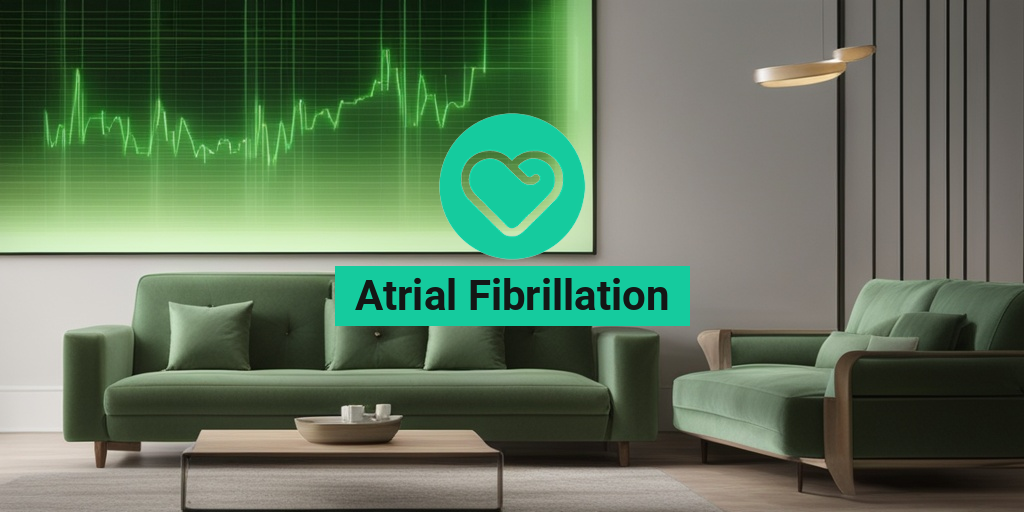What Is Atrial Fibrillation?
Atrial fibrillation, also known as AFib, is a type of irregular heartbeat or arrhythmia that affects the upper chambers of the heart, known as the atria. In a normal heart, the atria contract and pump blood into the ventricles, which then pump blood to the rest of the body. However, in atrial fibrillation, the atria quiver or fibrillate instead of beating normally, leading to an irregular heartbeat.
The heart’s electrical system plays a crucial role in regulating the heartbeat. Normally, the heart’s natural pacemaker, called the sinoatrial (SA) node, sends electrical signals to the atrioventricular (AV) node, which then transmits the signals to the ventricles, causing them to contract. In atrial fibrillation, the electrical signals become disorganized, causing the atria to quiver or fibrillate instead of beating normally.
Atrial Fibrillation Symptoms
Many people with atrial fibrillation do not experience any symptoms at all, while others may experience a range of symptoms, including:
Frequent Symptoms:
- Palpitations or irregular heartbeat: A feeling of the heart racing, pounding, or fluttering in the chest.
- Shortness of breath: Difficulty breathing or feeling winded even when sitting still.
- Fatigue: Feeling tired or exhausted even after resting.
- Dizziness or lightheadedness: Feeling faint or dizzy, especially when standing up.
- Chest pain or discomfort: Feeling of pressure, tightness, or pain in the chest.
Some people may also experience more severe symptoms, such as:
Less Common Symptoms:
- Fainting or near-fainting: Losing consciousness or feeling like you’re about to pass out.
- Weakness or numbness in the face, arm, or leg: Weakness, numbness, or tingling in the face, arm, or leg.
- Confusion or memory problems: Difficulty concentrating, remembering things, or making decisions.
If you’re experiencing any of these symptoms, it’s essential to consult with your doctor to determine the underlying cause and appropriate treatment. Remember, atrial fibrillation can increase the risk of stroke, heart failure, and other complications, so early diagnosis and treatment are crucial. 💊
For more information on atrial fibrillation and its management, consider consulting with a healthcare professional or visiting reputable online resources like Yesil Health AI (yesilhealth.com). 💻

Atrial Fibrillation Causes and Risk Factors
Atrial fibrillation, also known as AFib, is a type of irregular heartbeat that affects millions of people worldwide. But what causes this condition, and who is at risk of developing it? In this section, we’ll delve into the underlying causes and risk factors of atrial fibrillation.
Underlying Causes of Atrial Fibrillation
Atrial fibrillation occurs when the upper chambers of the heart, known as the atria, quiver or fibrillate instead of beating normally. This can happen due to various reasons, including:
- Electrical signals gone wrong: In a normal heart, electrical signals regulate the heartbeat. In AFib, these signals can become disrupted, causing the atria to quiver or fibrillate.
- Scarring or damage to the heart: Heart conditions like coronary artery disease, heart failure, or cardiomyopathy can cause scarring or damage to the heart, leading to AFib.
- High blood pressure: Uncontrolled high blood pressure can put extra strain on the heart, increasing the risk of AFib.
- Thyroid problems: An overactive or underactive thyroid gland can affect the heart’s rhythm, leading to AFib.
- Sleep apnea: This sleep disorder can increase the risk of AFib, especially in people with underlying heart conditions.
Risk Factors for Atrial Fibrillation
Certain factors can increase your risk of developing atrial fibrillation. These include:
- Age: AFib risk increases with age, especially after 65.
- Family history: Having a family history of AFib or other heart conditions can increase your risk.
- Heart conditions: Conditions like heart failure, coronary artery disease, or cardiomyopathy can increase the risk of AFib.
- High blood pressure: Uncontrolled high blood pressure can increase the risk of AFib.
- Obesity: Being overweight or obese can increase the risk of AFib.
- Chronic conditions: Conditions like diabetes, kidney disease, or lung disease can increase the risk of AFib.
Atrial Fibrillation Diagnosis
Diagnosing atrial fibrillation typically involves a combination of physical examination, medical history, and diagnostic tests. Here’s what you can expect during the diagnosis process:
Physical Examination
During a physical examination, your doctor will:
- Check your pulse to see if it’s irregular or rapid.
- Listen to your heart sounds using a stethoscope.
- Check for signs of heart failure, such as swelling in the legs or ankles.
Medical History
Your doctor will ask you questions about your medical history, including:
- Any previous heart conditions or surgeries.
- Any symptoms you’re experiencing, such as palpitations, shortness of breath, or fatigue.
- Any medications you’re currently taking.
Diagnostic Tests
Your doctor may order one or more of the following diagnostic tests to confirm an AFib diagnosis:
- Electrocardiogram (ECG or EKG): This test records the electrical activity of your heart.
- Holter monitor: A portable device that records your heart’s rhythm over 24-48 hours.
- Event monitor: A device that records your heart’s rhythm over a longer period, usually 1-2 weeks.
- Echocardiogram: A test that uses sound waves to create images of your heart.
By understanding the causes and risk factors of atrial fibrillation, you can take steps to reduce your risk and seek timely medical attention if you experience any symptoms. In the next section, we’ll explore the symptoms of AFib and what to expect during treatment. 💊

Atrial Fibrillation Treatment Options
Atrial fibrillation, also known as AFib, is a type of irregular heartbeat that can increase the risk of stroke, heart failure, and other complications. While there is no cure for atrial fibrillation, there are various treatment options available to manage the condition and reduce the risk of complications. In this article, we will explore the different treatment options for atrial fibrillation.
Medications
Medications are often the first line of treatment for atrial fibrillation. The type of medication prescribed will depend on the severity of the condition, the presence of underlying health conditions, and the individual’s overall health.
There are several types of medications used to treat atrial fibrillation, including:
- Beta blockers: These medications slow the heart rate and reduce the risk of complications.
- Anti-arrhythmics: These medications help regulate the heartbeat and reduce the frequency of episodes.
- Blood thinners: These medications reduce the risk of stroke and blood clots.
- Rate control medications: These medications slow the heart rate and reduce symptoms.
Cardioversion
Cardioversion is a medical procedure that uses electrical shock to restore a normal heartbeat. There are two types of cardioversion:
Electrical cardioversion: This procedure uses a low-energy shock to restore a normal heartbeat.
Pharmacological cardioversion: This procedure uses medications to restore a normal heartbeat.
Catheter Ablation
Catheter ablation is a minimally invasive procedure that uses heat or cold energy to destroy the abnormal electrical pathways in the heart that cause atrial fibrillation.
This procedure is often recommended for individuals who do not respond to medications or cardioversion.
Lifestyle Changes
In addition to medications and medical procedures, making lifestyle changes can help manage atrial fibrillation. These changes include:
- Quitting smoking: Smoking can increase the risk of complications from atrial fibrillation.
- Reducing stress: Stress can trigger episodes of atrial fibrillation.
- Getting regular exercise: Regular exercise can help reduce symptoms and improve overall health.
- Maintaining a healthy weight: Excess weight can increase the risk of complications from atrial fibrillation.
Atrial Fibrillation Medications
Atrial fibrillation medications are used to manage the condition and reduce the risk of complications. The type of medication prescribed will depend on the severity of the condition, the presence of underlying health conditions, and the individual’s overall health.
Beta Blockers
Beta blockers are commonly used to treat atrial fibrillation. They work by slowing the heart rate and reducing the force of the heart’s contractions.
Examples of beta blockers include:
- Metoprolol
- Atenolol
- Propranolol
Anti-Arrhythmics
Anti-arrhythmics are used to regulate the heartbeat and reduce the frequency of episodes.
Examples of anti-arrhythmics include:
- Flecainide
- Propafenone
- Amiodarone
Blood Thinners
Blood thinners are used to reduce the risk of stroke and blood clots.
Examples of blood thinners include:
- Warfarin
- Aspirin
- Dabigatran
It’s essential to work closely with a healthcare provider to determine the best treatment plan for atrial fibrillation. With the right treatment, individuals with atrial fibrillation can manage their condition and reduce the risk of complications. 💊

Atrial Fibrillation Surgery
Atrial fibrillation, also known as AFib, is a type of irregular heartbeat that can increase the risk of stroke, heart failure, and other complications. While medications and lifestyle changes can help manage the condition, some people may require surgery to treat atrial fibrillation. In this section, we’ll explore the different types of atrial fibrillation surgery and what to expect during the procedure.
Catheter Ablation
Catheter ablation is a minimally invasive procedure that uses heat or cold energy to destroy the abnormal electrical pathways in the heart that cause atrial fibrillation. During the procedure, a cardiologist or electrophysiologist will insert a catheter through a vein in the leg and guide it to the heart. The catheter is equipped with electrodes that can map the heart’s electrical activity and identify the abnormal pathways.
Once the abnormal pathways are identified, the cardiologist will use the catheter to apply heat or cold energy to destroy the tissue. This can help restore a normal heart rhythm and reduce the risk of complications. Catheter ablation is usually performed under local anesthesia and sedation, and the procedure can take several hours to complete.
Maze Procedure
The Maze procedure is a surgical treatment for atrial fibrillation that involves creating a pattern of scar tissue in the upper chambers of the heart to block the abnormal electrical pathways. The procedure is usually performed during open-heart surgery, and the surgeon will use a combination of incisions and cryoablation (freezing) or radiofrequency ablation (heating) to create the scar tissue.
The Maze procedure can be performed as a standalone procedure or in combination with other heart surgeries, such as heart bypass surgery or heart valve repair. The procedure can take several hours to complete, and the recovery time can vary depending on the individual’s overall health and the complexity of the procedure.
Laser Ablation
Laser ablation is a minimally invasive procedure that uses a laser to destroy the abnormal electrical pathways in the heart. During the procedure, a cardiologist or electrophysiologist will insert a catheter through a vein in the leg and guide it to the heart. The catheter is equipped with a laser fiber that emits a high-energy laser beam to destroy the abnormal tissue.
Laser ablation is usually performed under local anesthesia and sedation, and the procedure can take several hours to complete. The recovery time is usually shorter compared to the Maze procedure, and most people can return to their normal activities within a few days.
Atrial Fibrillation Lifestyle Changes
While medications and surgery can help manage atrial fibrillation, making lifestyle changes can also play a crucial role in reducing the risk of complications and improving overall health. Here are some lifestyle changes that can help manage atrial fibrillation:
Exercise Regularly
Regular exercise can help reduce the risk of atrial fibrillation by improving cardiovascular health and reducing stress. Aim for at least 30 minutes of moderate-intensity exercise, such as brisk walking, cycling, or swimming, most days of the week. It’s essential to talk to your doctor before starting any new exercise program, especially if you have any underlying medical conditions.
Manage Stress
Stress can trigger atrial fibrillation episodes, so it’s essential to manage stress levels through relaxation techniques, such as meditation, deep breathing, or yoga. Taking breaks throughout the day to stretch and move around can also help reduce stress.
Quit Smoking
Smoking is a significant risk factor for atrial fibrillation, so quitting smoking can help reduce the risk of complications. Nicotine replacement therapy, counseling, and support groups can help you quit smoking.
Limit Alcohol and Caffeine
Excessive alcohol and caffeine consumption can trigger atrial fibrillation episodes. Limiting or avoiding these substances can help reduce the risk of complications.
Get Enough Sleep
Getting enough sleep is essential for overall health, and it can also help reduce the risk of atrial fibrillation. Aim for 7-8 hours of sleep each night and establish a relaxing bedtime routine to improve sleep quality.
By making these lifestyle changes, you can reduce the risk of atrial fibrillation complications and improve your overall health. Remember to work closely with your healthcare provider to develop a personalized treatment plan that’s right for you. 💊

Frequently Asked Questions about Atrial Fibrillation
Atrial fibrillation is a complex condition that can be confusing for many people. Here are some frequently asked questions about atrial fibrillation to help you better understand this condition.
What is Atrial Fibrillation?
Atrial fibrillation, also known as AFib, is a type of irregular heartbeat or arrhythmia that originates in the upper chambers of the heart (atria). It is characterized by a rapid and irregular heartbeat, often exceeding 100 beats per minute.
What are the Symptoms of Atrial Fibrillation?
The symptoms of atrial fibrillation can vary from person to person, but common symptoms include:
- Fatigue
- Shortness of breath
- Palpitations
- Chest pain
- Lightheadedness or dizziness
- Confusion or memory problems
What Causes Atrial Fibrillation?
The exact cause of atrial fibrillation is often unknown, but it can be triggered by various factors, including:
- High blood pressure
- Heart valve problems
- Coronary artery disease
- Cardiomyopathy
- Thyroid disorders
- Electrolyte imbalance
How is Atrial Fibrillation Diagnosed?
Atrial fibrillation can be diagnosed using various tests, including:
- Electrocardiogram (ECG or EKG)
- Holter monitor
- Event monitor
- Stress test
- Echocardiogram
How is Atrial Fibrillation Treated?
Treatment for atrial fibrillation usually involves a combination of medications, lifestyle changes, and medical procedures. The goal of treatment is to:
- Control the heart rate
- Prevent stroke
- Relieve symptoms
- Improve quality of life
Can Atrial Fibrillation be Prevented?
While atrial fibrillation cannot be completely prevented, you can reduce your risk by:
- Maintaining a healthy weight
- Exercising regularly
- Managing stress
- Getting enough sleep
- Quitting smoking
- Limiting alcohol consumption
What is the Prognosis for Atrial Fibrillation?
The prognosis for atrial fibrillation varies depending on the underlying cause and severity of the condition. With proper treatment and lifestyle changes, many people with atrial fibrillation can lead active and normal lives.
💖 We hope this FAQ has helped you better understand atrial fibrillation. If you have any further questions or concerns, please consult your healthcare provider.




